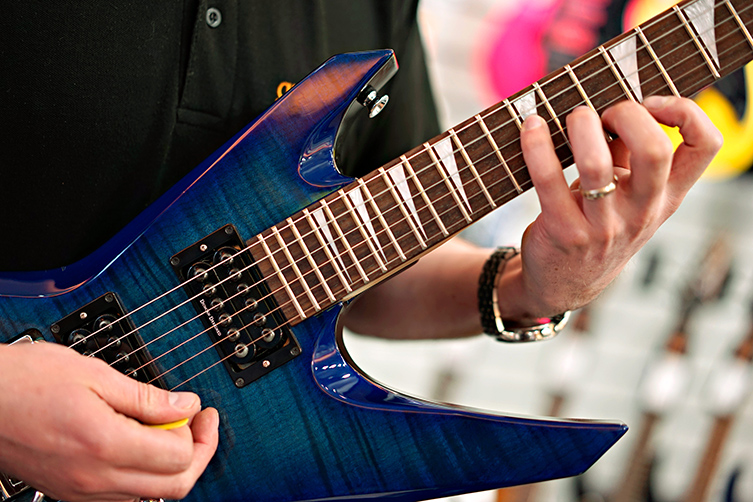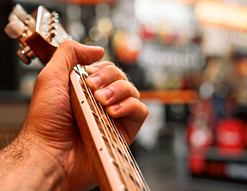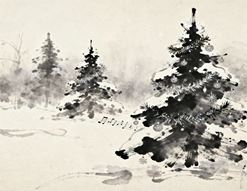Since the dawn of time, Man has worked and worked to better himself: through learning, venturing, daring and travelling into the furthest depths of unknown wildernesses to bring back knowledge and experience for the benefit of himself and his fellow brethren.
Thus it is with the alchemic art of lead guitar playing, otherwise known as SHRED.
It is not good enough to merely busk some John Lennon and bluff our way through a jaunty 12 bar blues. No, we did not begin walking this path to achieve mediocrity, we embarked on this arduous sonic adventure in order to become the greatest! To scale the heights of Mount Rock and peer down from the zenith, pointing at all who have not yet reached deep within themselves to find the strength and courage to be the best they can be, to shred on a guitar as no man, woman or elemental being has done before!
Well, fear not. We are here to guide you on the path and we offer up some magic keys in the form of techniques: sacred methods passed from master guitarists like Joe Satriani and John Petrucci directly to us in person. We want you to shine like the majestic shredding star that you are! Take these gifts of knowledge and apply them to your own strict practice regime: new dimensions in music will open before you.
Come with us: listen closely as we divulge arcane secrets from the deepest well of technique: secrets that we have worked tirelessly, painstakingly, to perfect. And remember: be wise and humble with your new powers, remembering always to share with your fellow musicians all that you find on your journey. Let us begin!
Good Practice
Okay, the fantasy-speak is tiring us out: let us speak plainly! If you are going to embark on any advanced technique on the guitar, it really is a matter of putting in the hours in a conscientious manner: you know the difference between jamming around and solid practice so make sure you have your metronome and a good hour spare before committing to learning this stuff.
Failure is fine as long as you keep going: much like getting fit after New Year, you don’t really notice all the hard work at first and you can lose heart and go back to the take-aways. That is not the path of Greatness! Keep practising steadily and diligently and, increment by increment, these things will get easier!
Practice slowly, much slower than you want to be able to perform the technique at. You may have heard people telling you that speed is a by-product of accuracy and that is the truest statement here! Make sure every note or hand movement is clean and accurate before moving on. There are few things in life as horrifying as a badly attempted shred solo full of bum notes and car-crash sweeps so don’t be that person! Do it right and sound spectacular!
Alternate Picking
Alternate picking is a technique that will serve you well far beyond the world of shred: it is a valuable tool for using in Country, Jazz and Surf genres, too. It basically refers to the act of picking up and down continually, one note up and the next down. It is very straightforward in theory so get to it! Grab your metronome and play combinations of single notes, all in alternate picking and all in a steady 16th note pulse. If you can perform this technique cleanly and consistently, your guitar should sound machine-like and efficient, making lots of Djent riffs and lead lines sound most impressive.
As you improve, gradually make your left hand more busy: turn notes into melodies and riffs but do not go into tremolo picking, which is just a case of buzzing away as fast was you can: keep to the steady rhythm and precision.
Look to Zakk Wylde as a master of this technique: when he took up the reigns with Ozzy Osbourne, following up on class acts like Randy Rhoads and Jake E Lee, he decided that, rather than compete with the jaw-dropping legato style of those guys, he would instead play every single note individually, using alternate picking. It has come to define his lead style and he is a bit of a legend so let’s get our alternate picking sorted!
Another living legend is Dream Theater’s John Petrucci and his alternate picking ability is terrifying. When we had the opportunity to talk with him, he stressed the importance of working slowly and diligently, paying attention to trouble spots in your technique and going over them again and again until they smooth over.
He also mentioned economy of movement in your right hand: keep it tight and your efficiency will improve. When John talks, you listen!
Tapping
Tapping tends to fall into two camps: the casual tap and the tapping frenzy. Both are impressive, both are (relatively) straightforward and both should be in your bag of tricks as soon as possible!
Casual tapping is when one or two notes are tapped in a piece of playing that otherwise has no tapping parts. Billy Gibbons is famous for this, as is tapping maestro Eddie Van Halen. In the middle of playing a little lead lick of any description, simply reach across with the index or middle finger of the right hand and tap any chosen note directly on the fingerboard. You do not pick the note first, it is more an extension of a legato (lots of hammer-ons and pull-offs played sequentially with little to no ‘actual’ picking) so just reach in there and smack that note!
As for note choice, that of course depends on what you are playing but the further apart the notes, the more dramatic the effect so make sure you go for a corresponding note on a different positioning of your given scale. For example, if you were playing a riff on the ‘A’ string with notes including a ‘C’ and a ‘D’, reaching over and cheekily tapping the ‘A’ string at the 10th fret with sound cool; tapping at the 19th will sound ever cooler! Experiment!
You can also tap on an entirely different string from the one you are currently playing but that requires more from your right hand since you don’t have the movement of a pre-plucked sting in your favour. It sounds wicked if you can master it though!
Tapping Frenzies are when we go all out and play entire passages using only tapping. ‘Eruption’ is the famous one and it’s a good place to begin since the taps are all constant triplets made from two left hand notes and one right hand tap at the beginning. Since Eddie wanted a classical effect, he kept his tapping very uniform, lending a regimented synth-like legato to the music that is very easy to follow and thus to copy.
SO, where do you put your pick? Good question. Some players palm their plectrum, holding it safe with their right hand ring finger; others (who won’t have to sing) put the pick in their teeth and others (like us) deliberately use their middle finger to tap with, leaving the pick where it usually is, between the thumb and index. Eddie goes one (typically eccentric) step further: he holds his plectrum (a .60 gauge as well, we were aghast to learn!) between thumb and middle finger, leaving his pointing digit free to tap himself silly. Whatever works!
Harmonics
Harmonics incorporate several techniques but we are heading from the shred angle here so this carries on from the tapping. Harmonics - natural points along the lengths of a string which can sound out high pitches without being fretted - are extremely potent tools to use in your expressive soloing. Plenty of heavy bands use them in their riffs as a point of dramatic contrast whilst others use them for the same reason but in their meticulously crafted solos.
To understand this, simply run any fretting finger along the low E string from fret 2 to fret 7 without pressing down on the string. Employ your new alternate picking technique as you do this and you’ll hear a bunch of high pitches flowing out of your guitar. These are all natural harmonics and they occur at certain points along the string. Knowing where is key to getting the most from them.
Some very strong harmonics occur at the 5th, 7th and 12th frets of each open string. Playing an open string and then lightly tapping the 7th fret of that string (not pressing down, remember) lets you have what is known as a tapped harmonic. Keep the numbers 5, 7 and 12 in mind anytime you play and you can create tapped harmonics in a similar way: playing the 4th fret of the ‘D’ string will mean you can tap out harmonics at the 9th, 11th and 16th frets. This applies all over the fretboard and is, we believe, something Pythagoras - one of the original Shredders - found out in the Pre-Metal age.
Extreme harmonics, Satch style
We were lucky enough to have a 5-minute chat with Master Shredder Joe Satriani a few years back and he kindly explained his dramatic harmonic technique with us. Yes, perks of the job. Anyway, the technique we refer to is the one with the whammy bar, where both hands seem to reach towards the guitar’s pickups before a hugely high note shoots out, aided by whammy bar manipulation. Now, even Joe said he only gets this right “80-84% of the time” and he was definitely being modest but the point is, even the best find this one pretty tough. In theory though, like all these things, it’s at least pretty easy to understand. Here’s how it’s done:
First off, learn where the actual harmonic points are on each string. These are not the 5, 7 and 12th fret ‘standard’ harmonics but those wild, spiky ones that have seemingly random pitches. Wound strings are easier to get results from so maybe focus on the ‘A’ and the ‘D’ strings. Use the fret running experiment from the previous paragraph up at the bridge end of the guitar and you will get similar harmonic results pinging out of the string. The idea here is to be able to locate these pitches based on their relative position along the string because you’ll need this later. Eyeball where the cool harmonics are and practice being able to get them straight away.
Next, once you know the string you want to perform this on and you know exactly where the appropriate harmonic lies, you grab the whammy bar, play the string and dive that bar down until the strings go slack! It needs to be a Floyd Rose trem or similar but we don’t need to tell you that do we? This isn’t Techniques for Rockabilly, now is it?
Okay, this is where it’ll either work and you’ll be remembered forever as a true Master of the Art, or it’ll miss and you’ll flub out completely, looking like giant loser as you do so. Make sure you practice this for AGES before you ever do it in front of another human.
Confidently and smoothly begin to bring the tremolo arm back up with your right hand. As you do this, reach across and over the guitar with your left hand and hold your best finger (middle probably but try things out) lightly over the exact harmonic point, touching the moving string ever so slightly as it makes its way back into being in pitch again. Too much and you’ll kill the note, too little and you won’t get what you want, which is a magnificently strong and high pitched harmonic, sounding out proudly instead of the regular pitch of the note and travelling up and up as the whammy bar is brought to pitch. The effect is thrilling!
The thrill is not over! Keep going! It’s a locking trem and since you’re a Master Shredder, you’ll have set it up to have tons of back-bend. Yank that trem arm up so your harmonic note continues to soar sky high, past the original specified pitch. Now you can either bring it back to normal and play another note and dive that bar again! Who’s going to stop you? You’re incredible!
Wow, now we are getting good! The path has been long and weary, traveller, but more musical gold awaits ahead!
Lizard down the throat
Now, THIS is a pretty strange sounding technique but oh boy does it sound special! Our friend from earlier, Joe Satriani, invented this technique and there is nothing much else that sounds like it.
First, an example: listen to Satch’s tune ‘Ice 9’ from his seminal ’Surfing With the Alien’ album and pay close attention to the third part of his solo, especially 2m 03secs in. Yes, THAT noise! The one that sounds like an angry growling dog, an alien motorcycle or, as Joe reckons, a lizard surfing down your throat.
Again, this is fairly easy to explain but really hard to nail. As if sounding like Joe Satriani were an afternoon’s work…
Pick a note, any note. For the purposes of the exercise any fretted note will do but try to go for one further down near the headstock. Now, what you need to do is play that note and then start moving both hands: your right hand is pressing down on the whammy bar and your left hand is physically moving up the frets, sliding up and - here’s the kicker - trying as hard as you possibly can to keep the original pitch of the first note you played! You want to move up the neck so the pitch is increasing at the same rate as the whammy bar is dipping the note.
Yes, it’s impossible. Thankfully, that is rather the point! It’s the note roughly going in and out of pitch with itself that causes the lizard to creep down your throat.
When you get to the end of the neck, do as Satch does and just brazenly go at it again. Extra noise adds to this technique for sure. This is difficult to pull off but it is not a finesse trick so don’t worry too much about handling noise and such. You’ll know when you’re getting the right effect. Presumably you will not feel any creatures in your throat at any point during this exercise.
Sweep picking
Finally, you Shred Titan, you Neoclassical Wizard, it is time to try some sweep picking. Sweep picking is the technique that seems to give guitarists the most problems and much of that is down to a lack of patience more than anything else.
Sweep picking is a technique whereby you play the notes of an arpeggio by raking or ‘sweeping’ your plectrum down (and then back up) the strings at a consistent speed. The left hand frets the notes of the arpeggio at the exact same time as the right hand picks the note, resulting in an almost synthesiser-like rainbow of notes. What makes this different from merely strumming an arpeggio is the fact that the left hand only briefly frets the note: the player uses each finger of his left hand to get four notes or indeed uses semi-barre techniques to grab some more notes for even greater flourish.

The key here, according to some wise advice from Mr Petrucci, is to keep things slow and just work on coordination. Much as before, slow and steady wins the race here. Sweeping is difficult, there is no argument, but slow and persistent practice will reap results. Get that metronome going nice and slow and just concentrate on timing, keeping your notes as clean as you can and going over any that are causing problems. As with Alternate picking, Petrucci advocates economy in movement, certainly with the left hand but particularly with the right.
In terms of WHAT to play when sweeping, that really isn’t for us to say but for a little guidance, diminished scales and Harmonic Minor scales are particularly effective when played as arpeggios. Keep it slow and keep it steady so that when you have the technique down, you will be able to casually fling out sweep licks that will floor your hitherto unsuspecting audience. And remember, if you aren’t brilliant at it, think twice about doing it at a gig at all: nothing fails like a terrible sweep lick.
Final thoughts
So there you have it, friends. Some special nuggets of gold from the lofty realms of Shredland. We wish you the luck of the Heavy Metals Gods as you practice your sonic magic: may you become a true Learned Master. The world needs you and your Shredability so work hard, keep the patience and reap the rewards.


























